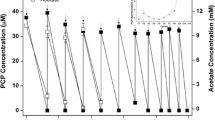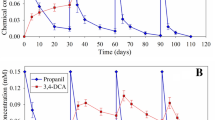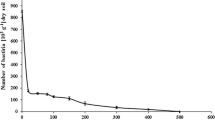Abstract
An anaerobic consortium degrading pentachlorophenol (PCP) by methanogenic fermentation was enriched from PCP-contaminated soils. In a semi-continuous reactor, PCP biodegradation was unstable and necessitated periodic additions of unacclimated anaerobic sludge waste to restore the activity. In continuous-flow reactors, PCP degradation activity was more stable when a mixture of glucose and sodium formate was used as secondary carbon source instead of glucose. The analysis of the chlorophenol intermediates suggested that the main pathway of PCP dechlorination was PCP → 2,3,5,6-tetrachlorophenol → 2,3,5-trichlorophenol → 3,5-dichlorophenol → 3-chlorophenol → phenol. In a laboratory-scale continuous-upflow fixed-film column reactor, a PCP removal of more than 99% was achieved at a PCP loading rate of 60 μmol (1 reactor volume)−1 day−1 for a hydraulic retention time of 0.7 day. Analysis of culture samples taken at different levels in the reactor have shown that, at this PCP loading rate, only the lower part of the reactor was active. 3-chlorophenol and 3,5- and 3,4-dichlorophenol were detected at the different levels of the reactor. A study of the microorganisms in the biofilm was carried out by scanning electron microscopy and suggested that the microorganisms involved in the consortium were present as a well-structured arrangement. Methanosaeta-like microorganisms were observed mainly at the base of the biofilm whereas, at the surface, a larger diversity of morphotypes was observed in which coccoid or small rod organisms were dominant. This work shows the importance of the design and the control of the operation parameters on the efficiency of the fixed-film reactor.
Similar content being viewed by others
References
Apajalahti JHA, Salkinoja-Salonen MS (1986) Degradation of polychlorinated phenols by Rhodococcus chlorophenilicus. Appl Microbiol Biotechnol 25:62–65
Armenante PM, Kafkewitz D, Jou C-J, Lewandowski G (1993) Effect of pH on the dechlorination of chlorophenols in a defined medium. Appl Microbiol Biotechnol 39:772–777
Béchard G, Bisaillon JG, Beaudet R (1990) Degradation of phenol by a bacterial consortium under methanogenic conditions. Can J Microbiol 36:573–578
Boyd SA, Shelton SR, Berry D, Tiedje JM (1983) Anaerobic biodegradation of phenolic compounds in digested sludge. Appl Environ Microbiol 46:50–54
Brown EJ, Pignatello JJ, Martinson MM, Crawford RL (1986) Pentachlorophenol degradation:a pure bacterial culture and epilithic microbial consortium. Appl Environ Microbiol 52:92–97
Guiot SR, Pauss A, Costerton JW (1992) A structured model of the anaerobic granule consortium. Water Sci Technol 25:1–10
Guthrie MA, Kirxch EJ, Wukasch RF, Grady CPL Jr (1984) Pentachlorophenol biodegradation. II. Anaerobic. Water Res 18:451–461
Hakulinen R, Salkinoja-Salonen M, Woods S, Ferguson J, Benjamin M (1985) Anaerobic treatment of pulp and paper industry wastewater. In: Viitasalo I (ed) Methane fermentation 85, report of a national seminar held at the University of Joensuu, Finland, 2–3 October 1985, Joensuu, Finland, pp 97–106
Hanson RS, Phillips JA (1981) Chemical composition. In: Manual of methods for general bacteriology. American Society for Microbiology, Washington, DC, pp 333–334
Hayat MA (1974) Principles and techniques of scanning electron microscopy. New York, Van Nostrand Reinhold
Hendriksen HV, Ahring BK (1992) Metabolism and kinetics of pentachlorophenol transformation in anaerobic granular sludge. Appl Microbiol Biotechnol 37:662–666
Hendriksen HV, Larsen S, Ahring BK (1991) Anaerobic degradation of PCP and phenol in fixed-film reactors:the influence of an additional substrate. Water Sci Technol 24:431–436
Hendriksen HV, Larsen S, Ahring BK (1992) Influence of a supplemental carbon source on anaerobic dechlorination of pentachlorophenol in granular sludge. Appl Environ Microbiol 58:365–370
Keith LH, Telliard WA (1979) Priority pollutants. 1. A perspective view. Environ Sci Technol 13:416–423
MacLeod FA, Guiot SR, Costerton JW (1990) Layered structure of bacterial aggregates produced in an upflow anaerobic sludge bed and filter reactor. Appl Environ Microbiol 56:1598–1607
Madsen T, Aamand J (1992) Anaerobic transformation and toxicity of trichlorophenols in a stable enrichment culture. Appl Environ Microbiol 58:557–561
Madsen T, Licht D (1992) Isolation and characterization of an anaerobic chlorophenol-transforming bacterium. Appl Environ Microbiol 58:2874–2878
Mikesell MD, Boyd SA (1985) Reductive dechlorination of the pesticides 2,4-D, 2,4,5-T and pentachlorophenol in anaerobic sludges. J Environ Qual 14:337–341
Mikesell MD, Boyd SA (1986) Complete reductive dechlorination and mineralization of pentachlorophenol by anaerobic microorganisms. Appl Environ Microbiol 52:861–865
Mikesell MD, Boyd SA (1988) Enhancement of pentachlorophenol degradation in soil through induced anaerobiosis and bioaugmentation with anaerobic sewage sludge. Environ Sci Technol 22:1411–1414
Mohn WW, Kennedy J (1992) Limited degradation of chlorophenols by anaerobic sludge granules. Appl Environ Microbiol 58:2131–2136
Murthy NBK, Kanfman DD, Fries GF (1979) Degradation of pentachlorophenol (PCP) in aerobic and anaerobic soil. J Environ Sci Health [B] 14:1–14
Nicholson DK, Woods SL, Istok JD, Peek DC (1992) Reductive dechlorination of chlorophenols by a pentachlorophenol-acclimated methanogenic consortium. Appl Environ Microbiol 58:2280–2286
Saber D, Crawford RL (1985) isolation and characterization of Flavobacterium strains that degrade pentachlorophenol. Appl Environ Microbiol 50:1512–1518
Salkinoja-Salonen MS, Hakulinen R, Valo R, Apajalahti J (1983) Biodegradation of recalcitrant organochlorine compounds in fixed film reactors. Water Sci Technol 14:309–319
Stinson M, Skovronek HS, Chresand TJ (1991) EPA site demonstration of Bio Trol aqueous treatment system. J Air Waste Manage Assoc 41:228–233
Tiedje JM, Boyd SA, Fathepure BZ (1987) Anaerobic degradation of chlorinated aromatic hydrocarbons. Dev Ind Microbiol 27:117–127
Wolin EA, Wolin MJ, Wolfe RS (1963) Formation of methane by bacterial extracts. J Biol Chem 238:2882–2886
Woods SL, Ferguson JF, Benjamin MM (1989) Characterization of chlorophenol and chloromethoxybenzene degradation during anaerobic treatment. Environ sci Technol 23:62–68
Wu WM, Bhatnagar L, Zeikus JG (1993) Performance of anaerobic granules for degradation of pentachlorophenol. Appl Environ Microbiol 59:389–397
Author information
Authors and Affiliations
Rights and permissions
About this article
Cite this article
Juteau, P., Beaudet, R., McSween, G. et al. Anaerobic biodegradation of pentachlorophenol by a methanogenic consortium. Appl Microbiol Biotechnol 44, 218–224 (1995). https://doi.org/10.1007/BF00164505
Received:
Revised:
Accepted:
Issue Date:
DOI: https://doi.org/10.1007/BF00164505




